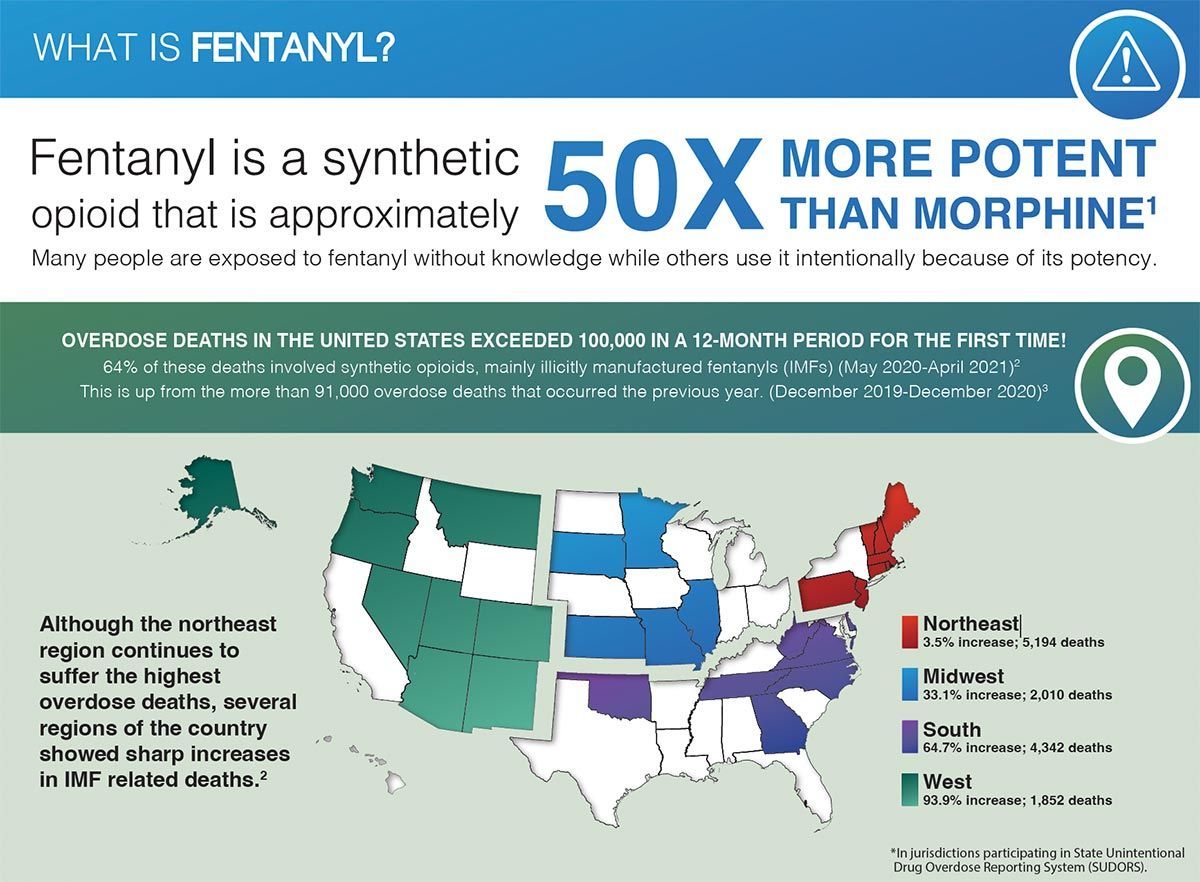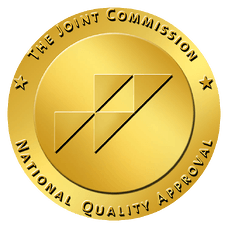Fentanyl Addiction Treatment and Rehab
Fentanyl: A Potent Synthetic Opioid Fentanyl is a synthetic opioid, renowned for its extraordinary potency—approximately 50 to 100 times that of morphine.1 Typically employed in hospitals following significant surgeries or treatments, this prescription medication can also be utilized in various other scenarios. Unfortunately, it is sometimes produced illegally, posing significant risks to those who opt to consume it.
Prescription fentanyl is also known as:
- Sublimaze
- Duragesic
- Actiq
Street names for fentanyl include:
- Dance Fever
- Goodfellas
- Murder 8
- Tango & Cash
- Jackpot
- Friend
- Apache
Complete the pre-screen form below to initiate the admission process. Our admissions team will contact you shortly.

What Makes Fentanyl So Dangerous?
Fentanyl poses a particular danger due to its remarkable potency in comparison to other opioids. As a synthetic opioid, it is estimated to be 50 to 100 times stronger than morphine, a natural opioid sourced from the opium poppy. This considerable strength implies that even a minute quantity of fentanyl can exert powerful effects on the body. Given its potency, fentanyl requires meticulous controls and should be administered with utmost care, as the margin for error is exceedingly slim. It is all too easy to unintentionally administer a dose that results in an overdose, underscoring the critical need for awareness and caution when dealing with this substance. Indeed, in 2017, fentanyl was involved in more than 50% of opioid-related fatalities in the United States.
How Do People Use Fentanyl?
Prescription fentanyl is administered in the form of a shot, lozenge, or patch. The lozenges are designed to be sucked like cough drops, gradually releasing the medication into the body. Patches enable the drug to seep through the skin slowly, providing effects over an extended period. In contrast, injections are delivered quickly and are typically given by anesthesiologists.
When it comes to illicit fentanyl, it may be found as an eye drop, nasal spray, pill, powder, or even applied to blotter paper. It is often mixed with other substances, such as heroin, cocaine, MDMA, or methamphetamine, to intensify the effects. However, the potency of fentanyl makes it incredibly easy to overdose, as even a small excess can lead to dangerous consequences.
What Are the Symptoms of Fentanyl Abuse?
The use of fentanyl can lead to a variety of symptoms. Some of the side effects associated with fentanyl include:
- Intense short-term highs
- Euphoria
- Nausea
- Fainting
- Seizures
- Fatalities
- Slowed breathing
- Lowered blood pressure
- Constricted pupils
- Sedation
- Vomiting
- Urinary retention
Depending on the dosage consumed, the effects of fentanyl—such as sedation, lowered blood pressure, slowed respiration, or seizures—may result in coma or even death.
Is Fentanyl Dangerous?
Fentanyl poses a significant danger due to the ease with which one can overdose on it. An overdose occurs when an individual consumes more fentanyl than their body can manage. Such an overdose can result in hypoxia, a condition where the brain is deprived of sufficient oxygen. If not addressed swiftly, this can ultimately lead to death.
What Are the Methods of Fentanyl Abuse?
When used unlawfully, fentanyl is typically injected, snorted, consumed as a pill, or applied to blotter paper. Individuals who possess fentanyl gel patches, which are available by prescription, may misuse them by extracting the gel and ingesting or injecting it. The DEA has reported incidents of these patches being cut into smaller pieces and placed in the cheek cavity or beneath the tongue. Illicitly manufactured fentanyl may also be combined with other substances, such as heroin, cocaine, MDMA, or methamphetamine. This combination significantly heightens the risk of severe side effects and overdoses.
Identifying Signs of a Fentanyl Overdose: What to Look For
A fentanyl overdose presents several clear symptoms. Among the most prevalent signs of an overdose are:
- Unconsciousness.
- Alterations in pupil size
- Respiratory failure
- Cyanosis
- Cold, clammy skin
- Coma
It's crucial to recognize that respiratory depression, coma, and pinpoint pupils indicate opioid poisoning. If you observe any of these symptoms, obtaining emergency medical assistance for the individual is vital. Neglecting to act could result in serious injury or even death.
What Are the Treatments for a Fentanyl Overdose?
A fentanyl overdose can be swiftly addressed with Naloxone. As an opioid antagonist, Naloxone works by reversing the effects of opioid drugs. Commonly referred to as NARCAN, this medication is accessible to EMS personnel, law enforcement, pharmacists, and other authorized professionals. Additionally, many individuals prescribed opioids are also provided with NARCAN to ensure its availability in the event of an accidental overdose.
What Symptoms Indicate Fentanyl Withdrawal?
Similar to other opioids, fentanyl presents certain distinct withdrawal symptoms that you should be aware of. Some possible withdrawal symptoms include:
- Muscle aches
- Restlessness
- Lacrimation
- Anxiety
- Frequent yawning
- Difficulty sleeping
- Runny nose
- Excessive sweating
- Goosebumps on the skin
- Rapid heart rate
- High blood pressure
- Dilated pupils
- Nausea
- Vomiting
- Abdominal cramping.
How Long Does Fentanyl Withdrawal Last?
The positive aspect is that withdrawal symptoms are typically short-lived. For the majority, opioid withdrawal symptoms start to improve within 72 hours, and they diminish considerably within a week.
How Are Symptoms of Fentanyl Withdrawal Treated?
The symptoms of fentanyl withdrawal can be highly distressing and, in some cases, may lead to significant risks. This highlights the necessity for patients to seek medical treatment in a regulated environment, as they often attain more favorable results than those who attempt to quit fentanyl suddenly or reduce their dosage independently. During the detoxification journey, it is crucial to acknowledge the varying degrees of withdrawal that can occur, from mild to severe. Moreover, complications can sometimes emerge.
Mild Withdrawal
Mild withdrawal from fentanyl can be uncomfortable, but it is generally not life-threatening. Typically, it can be managed with over-the-counter medications like ibuprofen or acetaminophen. Staying well-hydrated and getting sufficient rest is also beneficial, while medications such as hydroxyzine and loperamide can assist in alleviating nausea or diarrhea.
Intense Withdrawal
When patients experience more severe symptoms, hospitalization may be necessary during the withdrawal and detox process. Intense symptoms could require the use of clonidine, which has been found to alleviate withdrawal symptoms by approximately 50 to 75% in patients. Other medications available for managing withdrawal symptoms include Suboxone, a formulation of naloxone and buprenorphine, and methadone, a long-term opioid maintenance therapy. Each of these options can help reduce withdrawal symptoms, lessen their severity, and shorten the duration of detoxification. While methadone is classified as an opioid, it is intended for long-term maintenance. Although it is potent, its controlled application generally makes it safer compared to other stronger or more hazardous opioids.
Complications of Fentanyl Withdrawal
Opioid withdrawal is generally not life-threatening, but it can be exceedingly uncomfortable. For patients experiencing complications, some of the most prevalent issues include:
- Intense nausea
- Muscle cramping
- Diarrhea
- Vomiting
Given these symptoms, close monitoring is crucial. Nausea and vomiting can pose a risk of aspiration pneumonia if the vomit is inhaled. Additionally, diarrhea may result in an electrolyte imbalance, potentially leading to circulatory issues. In severe cases, such an imbalance could cause heart attacks or respiratory distress.
Individuals experiencing severe muscle cramping may endure significant pain, with some reporting acute joint pain as well. Fortunately, detoxification programs offer various options to alleviate these symptoms.
What Can You Expect from Elevate Recovery During an Outpatient Rehab Program?
When someone is addicted to fentanyl and enters into a detox and rehab facility, the first goal is to complete detoxification safely. This may mean taking long-term medications or being monitored while going through withdrawal in order to prevent serious symptoms, such as electrolyte imbalances.
Normally, detox starts within six hours of the last dose of a drug. Then, it takes up to 10 days for symptoms to totally dissipate. However, symptoms of withdrawal aren’t persistent. Some will come in waves. Symptoms usually peak 72 hours after the last dose taken, and they begin to decrease in severity after that time.
At Elevate Recovery, we prioritize a seamless transition from detoxification to rehabilitation to ensure our patients receive comprehensive care. After patients have successfully navigated the challenges of withdrawal, they immediately move into our intensive outpatient program. This stage is pivotal, as it addresses both the psychological and physical aspects of addiction.
Our rehabilitation process is rooted in dual-diagnosis treatment, tailored to identify and manage any co-occurring mental health disorders while treating substance abuse. We employ an array of therapeutic techniques, including behavioral therapy, which helps patients understand and change their thought patterns and behaviors related to substance use. Our group therapy sessions foster a sense of community and shared experience, while private counseling offers personalized attention to address individual challenges.
We recognize that some individuals may choose to forgo rehabilitation; however, this decision comes with heightened risks of relapse. Statistics show that without proper rehabilitation support, individuals face a significantly increased likelihood of returning to substance use. Therefore, we strongly recommend that patients complete both detoxification and rehabilitation within a treatment program tailored to their unique needs and specific addiction or dependency, enhancing their chances for lasting recovery and a healthier future.


